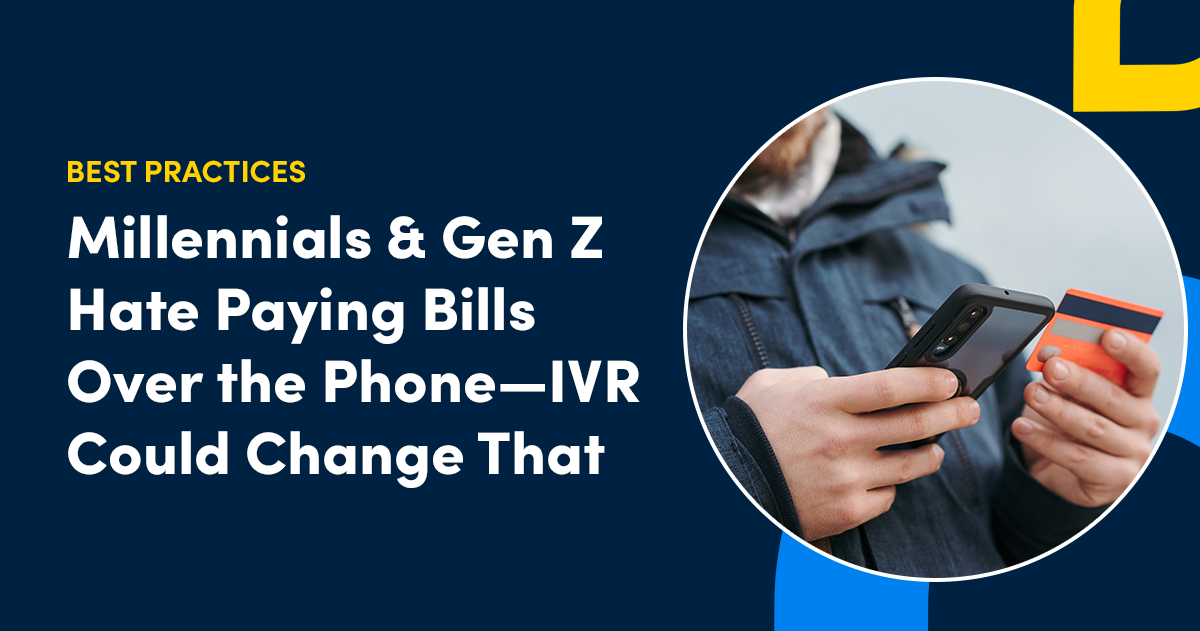Millennials & Gen Z Hate Paying Bills Over the Phone, But IVR Could Change That

Interactive voice response (IVR) payment systems have been around for quite a while now. Invented in the 1970s and put into heavy use in the 1990s in call centers around the world, IVR systems allow humans to interact with computer-operated phone systems using their voice and a phone’s keypad.
Today, IVR is often thought of as a common payment method for older bill payers who prefer making payments by phone but want the convenience of avoiding long wait times to speak to a live agent. However, there are many reasons younger payers can benefit from making payments via IVR, as well.
But Wait, Don’t Millennials & Gen Z Hate Phone Calls?
It’s true that there have been a wealth of studies showing Millennials (born between 1981 and 1996) and Generation Z (born between 1996 and 2015) actively avoid phone calls with a live agent whenever possible. For example, 75% of millennials avoid phone calls because they are time consuming.
When it comes to paying bills, we know that young payers want (and expect) information at their fingertips. Long telephone hold times and 24-hour turnaround of e-mail inquiries just won’t cut it.
In fact, according to research from BankMyCell, 75% of younger consumers list “time consuming” as the reason they actively avoid calls. Other reasons they avoid phone calls typically revolve around the fact that being on a call means dealing with people or simply not being in the right place or headspace to take that call.
How IVR Fits In
Fortunately, making payments via an IVR system doesn’t involve speaking to a “needy” human, potential verbal confrontation or wasted time. IVR calls can be made anywhere, anytime, at the payer’s convenience, reducing the anxiety 81% of young payers admit that they often experience anxiety when talking to someone on the phone.
IVR may seem like an outdated technology to some in the payments space. After all, why would younger payers want to call a computer when they could just open up their digital wallet or scan a QR code to pay?
While it’s true that these types of mobile payment options are popular with young payers, surprisingly, IVR could present a more convenient option in some cases.
Our recent consumer research shows that 51% of young payers (aged 18-29) find paying bills online difficult because they can’t remember their username, password or account number. 57% of those aged 30-44 said the same.
By calling into an IVR instead of using online channels (which typically would require them to log in using this information), these younger payers could remove the stress of keeping track of this data, particularly their login passwords.
A New (Old) Way to Connect with Younger Customers
IVR could be a hidden gem for your younger customers, who don’t want to make small talk on a live phone call or in person with an agent or have to remember multiple passwords and other online login information to make a payment.
Maybe you’ve been overlooking promoting IVR to your younger customers. Along with the reasons we’ve already covered, here are a few more benefits of IVR for your business.
PayNearMe’s IVR Benefits
- Allow payers to set their language preferences (e.g. English or Spanish)
- Customize voice prompts (tailor content to your brand)
- Give customers an easy option to make payments at their convenience
- Reduce operational costs by removing the need for agent-led payments
- Set or remove convenience fees, dependent on your business goals
- Verify customer information to reduce risk/fraud concerns
- Give customers the option to save payment methods in the system for future use
- Remove the need for customers to remember login information
- Get started quickly – no heavy technical work involved
Ready to re-think IVR? Contact us today for advice on getting started.



